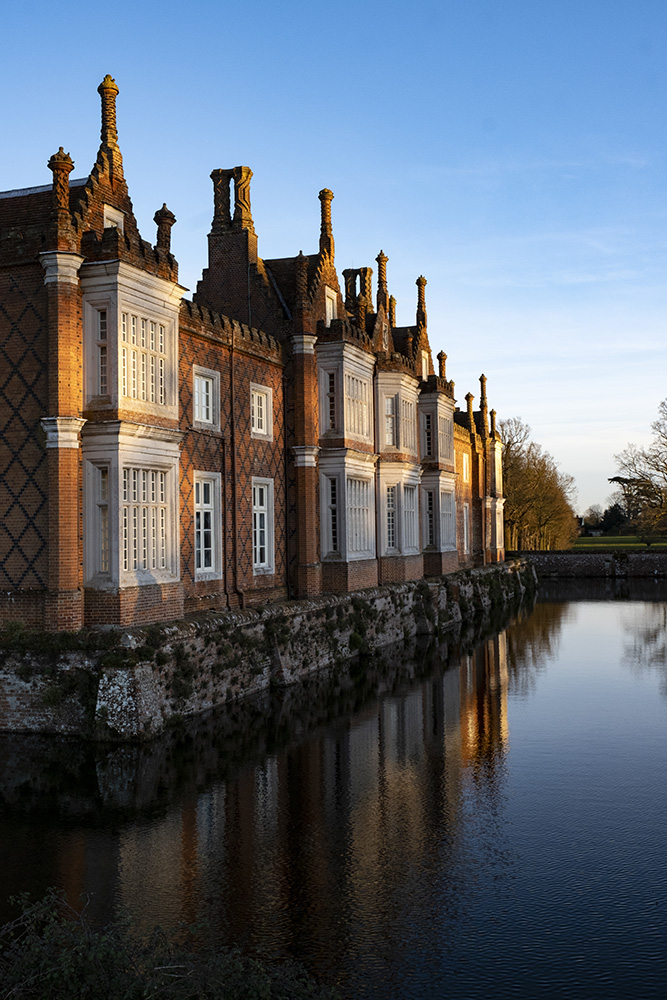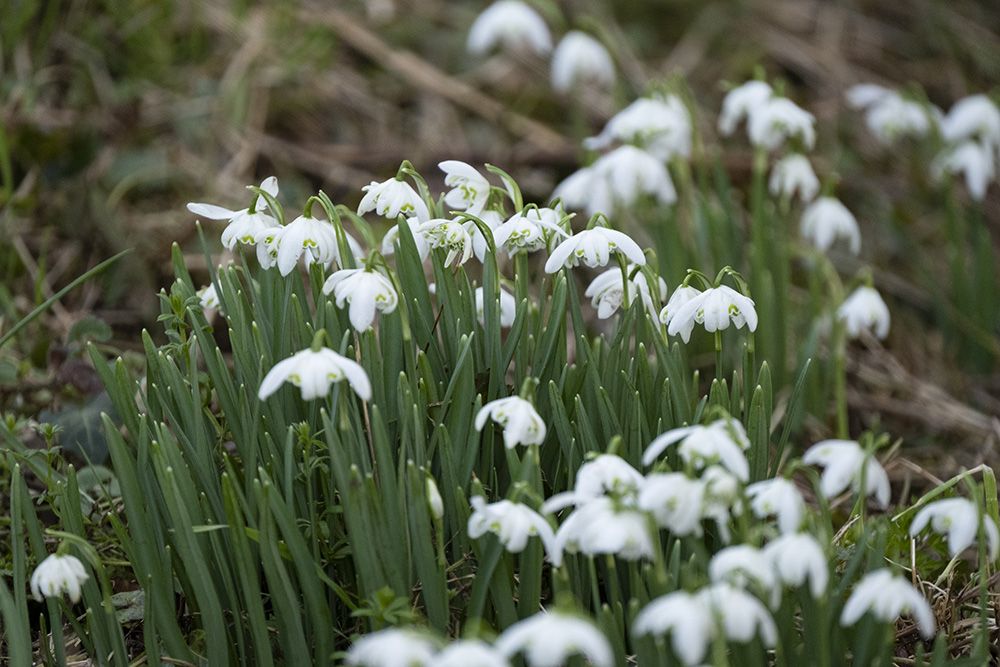“I can’t believe I was up early on New Year’s Day, but I was up for first light and excited to start this project. It was cold, though not especially so for January in England, but it was a very dull, uninspiring day. Today wasn’t about taking pictures though; it was the day to recce-ing the whole estate. I needed to start getting a feel for where the deer move within this landscape and whether there’s a pattern to these movements, especially in the early morning when the winter light is soft and often misty.”






My photography started the following day on the 2nd January with the unexpected. Each year the house and part of the gardens are illuminated for Christmas and New Year. Normally this is open to the general public but last winter was anything but normal in the face of a global pandemic. Just after sunset I started to shoot, looking for the last light of the day behind the house during the blue hour. The sky was still mostly cloudy but there was a clear strip near the horizon – enough to act as a backdrop for the house, while the still air gave almost perfect mirror-image reflections in the moat. There’s something magical about illuminations and reflections. I have to say I wasn’t expecting this start to the project but it yielded some rather enchantingly different views of Helmingham Hall in its setting.
The project photography the park started a few days later with the first really heavy early morning frost of the year. It could have been mistaken for light snow. The air was slightly misty and a hoar frost – where moisture in the air freezes on the grass and tree branches – clung to the trees making them look like they’d been dusted with crystalised icing sugar. It’s very beautiful.
In case I didn’t know already, the deer made it very clear that they were less than at ease with my presence that day and kept a distance. This afforded me the opportunity to observe their behaviour whilst focusing on the landscape. I captured some scene-setter images of the magnificent oak trees and the herds in situ among them with glimpses of the house and monument on the mound – a mound which had been used for shooting practice of a different kind during the Napoleonic wars.




With future shots in mind, I experimented with different ways to get closer to the deer. Slow, indirect movement, stopping and observing – taking my time seemed to be the key factor. Keeping a distance at first allowed them to get used to my presence and guardedly perceive me as less of a threat, or not an imminent threat at least. Under the watchful eyes of their lookouts and the occasional alarm calls, I gradually managed to get closer. This was still long-lens territory, though, and it already seemed that a 400m focal length was going to be a big part of this project. Thank goodness for image stabilisation!

January weather can be full of contrasts. If we get snow in this part of the UK – and it’s by no means guaranteed – then it generally comes sometime between January and March, and often only for a day or two. In between there are many grey days and wet, cold days but there can also be some sparkling sunny ones – this can’t be January in England kind of days! As you can see from the photos, there were days when this particular January sparkled.
At the start of this project I’d identified three specific challenges which would need to be part of the project, but may be difficult to capture, though undoubtedly there would prove to be many more. The deer giving birth, or with new-borns, was one and the second was the rutting season when testosterone fuelled stags can be very aggressive and dangerous. The third was the estate in the snow. I thought it could look incredible – a dull grey brown landscape with barren trees transformed into a magical snow kingdom like a scene from Narnia. I’d had a glimpse of the transformation with the heavy frost days, but only a glimpse.
In preparation I had the car ready with a shovel, just in case, and next to my camera gear, my warm winter clothing with thick socks and boots on standby. A few hours wandering through the deer park in the frost made these essential for all my early morning shoots. Personally, I love the cold mornings; with the right gear on, the cold doesn’t matter. The air is either crisp or misty, with a reflected brightness, which makes for atmospheric shots.
I got lucky! The snow came on 15th January and Narnia came alive. Through the gates of the estate I could see the avenue of oaks disappearing into the falling snow and shrouding a distant, faint outline of the house. I’m like a big kid. The snow excites me and just to be out in it is exhilarating, but I was aware that I probably only had a limited window so I needed to find some shots. Falling snow made the conditions harder to work in but it added a different dimension to the images, whilst playing with distance perception.



Photographing the building itself was relatively easy so first I turned my attention to the natural landscape and the deer huddled together or rooting for food. The falling snow blew in the wind and clung, windward, to the trunks of the oak trees. In the snow, I was probably less conspicuous and managed to get closer to the deer, but in this snow the wider shots, including the majestic trees, seemed to work better and were certainly more atmospheric.





Some fallow deer were near a small group of magnificent oak trees, branches long and twisted. I watched and waited from a distance. I had a shot in my head, a wide shot with a stag amongst the bold, tangled trees. Detail was unimportant here, it was all about mood.
I’d set my camera ready. Limited by relatively low light and a long focal length, I had the added complication of having to over-expose for the predominantly snowy white landscape. A tripod would have helped, but I decided on hand-held because I needed to react quickly to a fluid scene and the chances were the deer would walk through the shot rather than stand waiting for me to press the shutter. I was right.
A small group of four fallow deer approached the trees from the right, the shot – or potential shot – began to unfold. I needed a lone deer though. In moments one had moved ahead, paused by a tree and looked back at his compatriots. Click! Within moments the other stags had joined him or passed together through the frame and the shot was gone. Through pre-visualisation and preparation I had my shot though, and probably Helmingham Hall’s next Christmas card.

I made regular visits to Helmingham in January and February, assessing the light and the winter landscape. Sometimes I didn’t even take any pictures, sometimes just the odd one or two, but this was good for making me slow down and consider both what I was seeing and how I wanted the project to evolve. Even though I was shooting on a digital camera, I felt I needed a more measured approach as if I were shooting on film. I was still very much learning the landscape too.


The snow was gone or at least going by the next day. Within a week the skies were blue and the air still. Late afternoon sun lit up a different world as the house sat beside its reflection in a mirror-like moat. The contrast with a few days earlier couldn’t have been greater. With such a large estate it is almost always possible to view the landscape and inhabitants from any direction. A soft winter afternoon presented a great opportunity to experiment with backlit and high key imagery. Again, I would have plenty more opportunities to perfect this during the year but that low, soft winter sun made the results rather pleasing and different.


The snow returned again for a brief visit in mid-February, the 13th to be precise. Having visited only two days earlier I was somewhat surprised when that day’s visit presented a small group of three Soay ewes with new-born lambs in close attendance. Their introduction to the world was a cold, snowy one.



With a project like this it is so important to be aware of natural events as they present opportunities. The seasons produce broad brush changes but other events like full moons, eclipses and meteor showers offer other possibilities for ‘different’ imagery. Right at the start I’d visualised a shot of a full moon rising over the house.
Having checked moonrises and moonset times, where and when they occurred in the sky using websites, like timeanddate.com and apps like Photographers’ Ephemeris, not only helped me to plan shoot dates but more details of time and direction helped to determine shooting positions too. Of course, nothing is that simple. The weather or even just a bank of cloud blowing through at the wrong moment can scupper even the best plans, but the planning gives the best likelihood of getting lucky.

February’s Snow Moon on the 27th gave me the first opportunity. The forecast was good, or good enough, the moonrise was about 15 minutes after sunset – pretty much guaranteeing a warm coloration. The moonrise direction would see it rise just behind the back of the house. I got there early, found my position, checked and checked again. Moonrise time came and passed but no moon. I waited then I realised that Helmingham is slightly elevated and distant hills, plus a line of trees, had hidden the actual moment of moonrise. Ten to fifteen minutes later a pink moon emerged from behind the old stables near the far back corner of the house and climbed above the chimney stacks. The planning had paid off at the first attempt and the weather had cooperated.

By the end of February there was the first sense that winter was drawing slowly to a close. Snowdrops poked their heads out to signal it. What I’d gained from these two months – which are often considered the year’s bleakest – was an insight into how much life and light bring to the landscape, even the bleakest winter one, if you take the time to look. The beauty is there. It may have been more transitory and infrequent but it is there nonetheless.
In Part Three, we’ll take the first footsteps into spring and see what we find….

